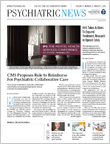Video and digital technology is expanding the reach of physicians to remote and rural areas of the country. For psychiatrists in short supply in many areas of the country, telepsychiatry has the potential to improve access to mental health treatment.
Here are some “nuts and bolts” about a rapidly emerging technology.
Q: What is telemedicine?
A: Telemedicine, as defined by the American Telemedicine Association (ATA), is “the use of medical information exchanged from one site to another via electronic communications to improve a patient’s clinical health status.” Over the past several decades, the use of telemedicine as an alternative to patient-doctor, face-to-face care has increased and includes multiple therapeutic modalities, including two-way video communication, email, smartphone applications, and more. The early years of telemedicine focused on delivering care to patients in rural and remote areas. Now, telemedicine is used widely in hospitals, home health agencies, and private practices, among other settings.
Q: How do psychiatrists fit in?
A: Telemedicine in psychiatry, known as telepsychiatry, has also seen substantial growth over the past decade. With increased access to high-speed broadband internet access in conjunction with widespread use of high-quality video cameras built into computers, smartphones, and tablets, psychiatrists are increasingly turning to telepsychiatry as a means of expanding or augmenting their practice.
Recently, APA updated its position statement on telepsychiatry as follows:
“Telemedicine in psychiatry, using video conferencing, is a validated and effective practice of medicine that increases access to care. APA supports the use of telemedicine as a legitimate component of a mental health delivery system to the extent that its use is in the best interest of the patient and is in compliance with the APA policies on medical ethics and confidentiality.”
Q: What are some important considerations when practicing telepsychiatry?
A: Many studies have compared the clinical effectiveness of telepsychiatry with in-person treatment. The general consensus is that, while additional research is needed, practicing telepsychiatry appears to be feasible across multiple care settings and that patient outcomes are, in general, similarly positive.
However, there remain several practical issues related to telepsychiatry of which clinicians should be mindful when considering adding telepsychiatry to their therapeutic repertoire:
•
Videoconferencing and security:
There are a number of live videoconferencing options on the market—many of which are available for free. However, the degree to which some videoconferencing applications (or “apps”) adhere to various federal security regulations, including the Health Insurance Portability and Accountability Act (HIPAA), remain nebulous. Some apps purport to be HIPAA compliant, whereas some meet the HIPAA standard only after the user agrees to a business associate agreement (BAA) with the vendor. When evaluating software or third-party vendors that host videoconferencing (many of which cater specifically to health care/telemedicine), it is important to ask whether the software meets certain HIPAA requirements, such as data encryption and security standards.
Presently, the degree to which a clinician may practice telemedicine varies by state. Most states require that a clinician be licensed in the state in which the patient resides and in which the clinician practices. Some states allow out-of-state physicians to practice telemedicine without an in-state license as long as the standard of care is met. Before integrating telemedicine into your practice, it is a good idea to contact your malpractice carrier to determine your state’s (and any state in which you wish to practice) regulations on telemedicine.
Reimbursement for telepsychiatry services is—like licensure issues—highly variable state to state. Parity between reimbursement for in-person and telemedicine encounters is not yet a reality in all states, especially for third-party payers. If you accept private insurance, it is a good idea to find additional information as to whether the insurance that you accept also reimburses for telepsychiatry. Additional information can also be found on the American Telemedicine Association’s
website under its “State Legislation Matrix”.
•
Clinical Practice Issues:
While there are many similarities between practicing psychiatry face to face with a patient versus using videoconferencing, there are some differences with which clinicians should be familiar before engaging in telepsychiatry. A good starting point is to become familiar with current practice guidelines for this form of therapy. In 2013, the ATA’s Telemental Health Work Group, composed of a diverse group of mental health professionals, released “Practice Guidelines for Video-Based Online Mental Health Services.” That resource can be found
here.
Q: How can APA help you make use of telepsychiatry?
A: APA continuously monitors federal and state regulations and legislation related to telemedicine and telepsychiatry, especially on issues pertaining to reimbursement and licensure. Additionally, APA’s Committee on Telepsychiatry is exploring many practical, clinical, and policy issues related to telepsychiatry and welcomes input from the broader APA membership.
Finally, APA recently launched its
Telepsychiatry Toolkit, an evolving resource for members who want to learn more about telepsychiatry. The toolkit includes videos, links to clinical and policy documents, and other pertinent educational resources. ■
More information on telepsychiatry and risk management can be accessed
here.
